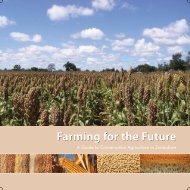Restoring the Soil - Canadian Foodgrains Bank
Restoring the Soil - Canadian Foodgrains Bank
Restoring the Soil - Canadian Foodgrains Bank
You also want an ePaper? Increase the reach of your titles
YUMPU automatically turns print PDFs into web optimized ePapers that Google loves.
Decision Tree Guide39hardy that <strong>the</strong> biggest worry for years with respect to this species was that it wasdifficult to eliminate. One method to remove this species from a field is by pruningit down to <strong>the</strong> soil surface at <strong>the</strong> beginning of <strong>the</strong> dry season. If you selectthis system (described in S7), proceed to #5.15. Potatoes. Tarwi (Lupinus mutabilis) can be used at <strong>the</strong>se altitudes (Photo 14).Tarwi is used in a number of ways to fertilize white potatoes in <strong>the</strong> Andean countries.Tarwi produces a traditional, still widely-consumed edible bean, although itmust be washed and cooked before consumed. Tarwi is an erect plant that reachesabout 1.5 m in height. It is also one of <strong>the</strong> best legumes in <strong>the</strong> world in terms offixing nitrogen and produces up to 400 kg N/ha. Choose between systems S32,S33, S34 and S35, and <strong>the</strong>n go to #5.16. Fruit trees. See information on tarwi in #19. See S40 and <strong>the</strong>n go to #5.17. Area’s main crop? What is <strong>the</strong> main crop in <strong>the</strong> area? If maize, go to #18. Ifwhite potatoes, go to #19. If fruit trees, go to #20. If it is various o<strong>the</strong>r annualcrops, go to #21.18. Gm/ccs for medium-altitude maize. Both fava beans (Vicia faba) (Photo 18) andrunner beans (Phaseolus coccineus) are commonly intercropped with maize. (Seedescriptions of <strong>the</strong>se in #14.) If <strong>the</strong> farmers prefer fava beans, use S6 and go to#5. If <strong>the</strong>y would prefer runner beans, use S13 and go to #5.19. Potatoes. Tarwi (see #15) can be planted with potatoes in a variety of ways. Iffarmers prefer to use tarwi in a rotation with potatoes, choose S32. If <strong>the</strong>y preferto grow it along <strong>the</strong> borders of <strong>the</strong>ir potato fields, use S33. If <strong>the</strong>y choose tointercrop it among <strong>the</strong>ir potatoes, use S34. In each case, return to #5.If farmers would prefer to grow fava beans (described in #14) with <strong>the</strong>ir potatoes,see S35, and go to #5.20. Fruit trees. Select S40, and <strong>the</strong>n go to #5.21. O<strong>the</strong>r crops. Consider S40 and S63. If you decide in favor of ei<strong>the</strong>r, go to #5.22. Below 800 m? If <strong>the</strong> region is between 800 m and 1,500 m in elevation, or in atemperate zone, go to #27. If within <strong>the</strong> tropics and below 800 m in elevation,consider using dispersed shade along with <strong>the</strong> low-stature gm/ccs. Go to #23.23. Dispersed shade. Dispersed shade refers to a light tree cover (about 15% to 20%shade) that is maintained over a field in <strong>the</strong> lowland tropics. In <strong>the</strong>se areas, <strong>the</strong>mid-day heat is so intense that all unshaded crops stop growing for two or threehours in <strong>the</strong> middle of <strong>the</strong> day. A light shade will create a favorable microenvironmentthat can increase crop yields by about 40%. Scientific experimentshave shown that 15% shade will also increase <strong>the</strong> growing period of crops by at
















